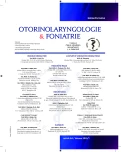Haemophilus influenzae b in Acute Middle Ear Inflammations and Meningitor of Otogenic Origin in Children after Introduction of Vaccination with Anhihemophilus Vaccine
Authors:
G. Forstová; I. Šlapák
Authors‘ workplace:
Klinika dětské otorinolaryngologie LF MU a FN Brno, přednosta prof. MUDr. I. Šlapák, CSc.
Published in:
Otorinolaryngol Foniatr, 64, 2015, No. 1, pp. 8-12.
Category:
Original Article
Overview
Introduction:
Streptococcus pneumoniae, Haemophilus influenzae a Moraxella catarrhalis belong to most frequent causes of acute middle ear inflammations.
A study performed at the Clinic of Child Otorhino-laryngology, Faculty Hospital at Brno, investigated, whether and how the spectrum of pathogens causing acute otitis and meningitis of otogenic origin after introduction of vaccination against Haemophilus influenzae b /further Hib/. The vaccine was integrated in the vaccination calendar of children since 1st July, 2001.
Materials and methods:
In the years 2002 – 2012 the authors performed a survey in two groups, where samples from auditory meatus were sample from children with acute otitis after paracentesis born before 2001 and not vaccinated against Hib (a control group) and in patients with acute otitis after paracentesis, who were compulsorily vaccinated against Hib and born after 2001 (the investigated group). Another investigated index was the incidence of meningitis of otogenic origin and the spectrum of agents in both groups.
Results:
In the control group was authors sample 205 smears of auditory meatus altogether for cultivation in children with acute otitis after paracentesis born until 2001. In the Hib unvaccinated patients with the diagnosis of acute otitis, agents detected from the microbiological smears were most frequently Streptococcus pneumoniae (45.85 %), Haemophilus influenzae b (26.34 %), Streptococcus pyogenes (9.27 %) and Moraxella catarrhalis (6.83 %). In meningitis of otogenic origin, we encountered Streptococcus pneumoniae in three cases, Streptococcus pyogenes in two, Staphylococcus aureus in to as well, Hib was cultivated once as well as Haemophilus influenzae non b.
In the investigated group, 201 smears of auditory meatus were sampled altogether in children with acute otitis after paracentesis and born after 2001 and compulsorily vaccinated against Hib.
In the Hib vaccinated children with acute otitis the most frequently detected microbe was Streptococcus pneumoniae (52.24 %), followed by Streptococcus pyogenes (10.45 %), Staphylococcus aureus (8.96 %), Moraxella catarrhalis (7.46 %), Haemophilus influenzae b was detected only in 4.48% vaccinated children with acute otitis.
In children with meningitis of otogenic origin Streptococcus pneumoniae was cultivated four times, Staphylococcus aureus twice as well as Staphylococcus coagulase negative and Streptococcus agalactiae, while Haemophilus influenzae non b was cultivated once.
Discussion and conclusions:
In this 10-year study there is an apparent decrease of Hib occurrence of microbiological findings in vaccinated children with acute otitis against results of microbiological findings in unvaccinated children.
In the group of vaccinated children there was not any case of meningitis caused by Hib. The vaccination provides a complete protection against serious invasive disease, meningitis in our case, and decreases the number of complications in common ORL infections.
Keywords:
Haemophilus influenzae b, otitis, meningitis, compulsory vaccination
Sources
1. Bouskela, M. A., Grisi, S., Escobar, A. M.: Epidemiologic aspects of Hib infection. P. A. Journal of Public Health, 2000.
2. Bannister, B. A. a kol.: Infectious disease. Blackwell Science, 2000.
3. Dagan, R., Frase, D., Roitman, M. et al.: Effectivenes of a nationwide infant immunization program agains Haemophilus influenzae b vaccine. Pediatr. Infect. Dis. J., 1999, s. 134-141.
4. Duben, J. a kol.: Vyšetření při bakteriálních onemocněních. Avicenum, Praha, 1986.
5. Havlík, J. et al.: Infekční nemoci. Galén, Praha, 2002.
6. Hobstová, J.: Hnisavé meningitidy v dětském věku. Galén, Praha, 1999.
7. Hobstová, J., Petráš, M., Kostřicová, E. et al.: Problematika meningitid vyvolaných Haemophilus influenzae b v souvislosti s plošnou vakcinací proti Haemophilus influenzae b. Klinická mikrobiologie a infekční lékařství. 1998, 2, s. 70-73.
8. Křížová, P.: Hemofilové vakcíny a jejich použití v České republice. Pediatrie pro praxi, 2001, 1, s. 13-15.
9. Křížová, P., Lebedová, V.: Sledování selhání vakcíny proti H. influenzae b. Zprávy CEM (SZÚ, PRAHA), 2003, 12/2, s. 76-77.
10. Křížová, P., Lebedová, V., Be-neš, Č.: Surveillance závažných onemocnění způsobených Haemophilus influenzae b v České republice v roce 2002. Zprávy CEM SZÚ, 9, 5.
11. Křížová, P., Lebedová, V., Be-neš, Č.: Vliv rutinní vakcinace v České republice na výskyt invazivních onemocnění způsobených Haemophilus influenzae b. Klinická mikrobiologie a infekční lékařství, 2004, 3, s. 118-123.
12. McVernon, J., Johnson, P. D. R., Pollard, A. J. et al.: Imunologic memory in Haemophilus influenzae b conjugate vaccine failure. Arch. Dis. Child, 2003, s. 379-383.
13. Metodický návod k zajištění surveillance programu invazivních onemocnění způsobených H. influenzae b. Věstník MZ ČR 2003, částka 13, s. 15-19.
14. Peltola, H.: Haemophilus influenzae b disease and vaccination i Europe:leasons learned. Pediatr. Infect. Dis. J., 1998, 17, s. 126-132.
15. Rožnovský, L., Krejčí, J.: Hemofilová sepse u tříletého dítěte. Čs. Pediatrie, 1996, 6, s. 353-354.
16. Šlapák, I. a kol.: Dětská otorinolaryngologie, Mladá Fronta, a. s., Brno, 2013.
17. Urbášková, P.: Surveillance rezistence k antibiotikům u nejčastějších bakteriálních původců respiračních infekcí v České republice. Remedia, 2000.
18. Votava, M.: Lékařská mikrobiologie speciální. Neptun, Brno, 2003.
19. Wegner, J. D.: Epidemiology of Haemophilus influenzae disease and impact of Haemophilus type b conjugate vaccines in the United States and Canada. Pediatr. Infect. Dis. J., 1998, s. 132-136.
20. Zjevíková, A., Rožnovský, L., Křížová, P., Lebedová, V.: Hemofilová meningitida u řádně očkovaného dítěte. Klinická mikrobiologie a infekční lékařství, 2004, 1, s. 22-24.
Labels
Audiology Paediatric ENT ENT (Otorhinolaryngology)Article was published in
Otorhinolaryngology and Phoniatrics

2015 Issue 1
Most read in this issue
- Relevance of Measurement of Nasal Nitric Oxide as Bioindicator of Inflammation in Otorhinolaryngology
- Cogan's Syndrome
- First Experience with Inner Ear Imaging Using Magnetic Resonance after Intratympanic Application of Contrast Medium
- Diffuse Large B-cell Lymphoma as the Most Common Non-Hodgkin B-cell Lymphoma of the Head and Neck
